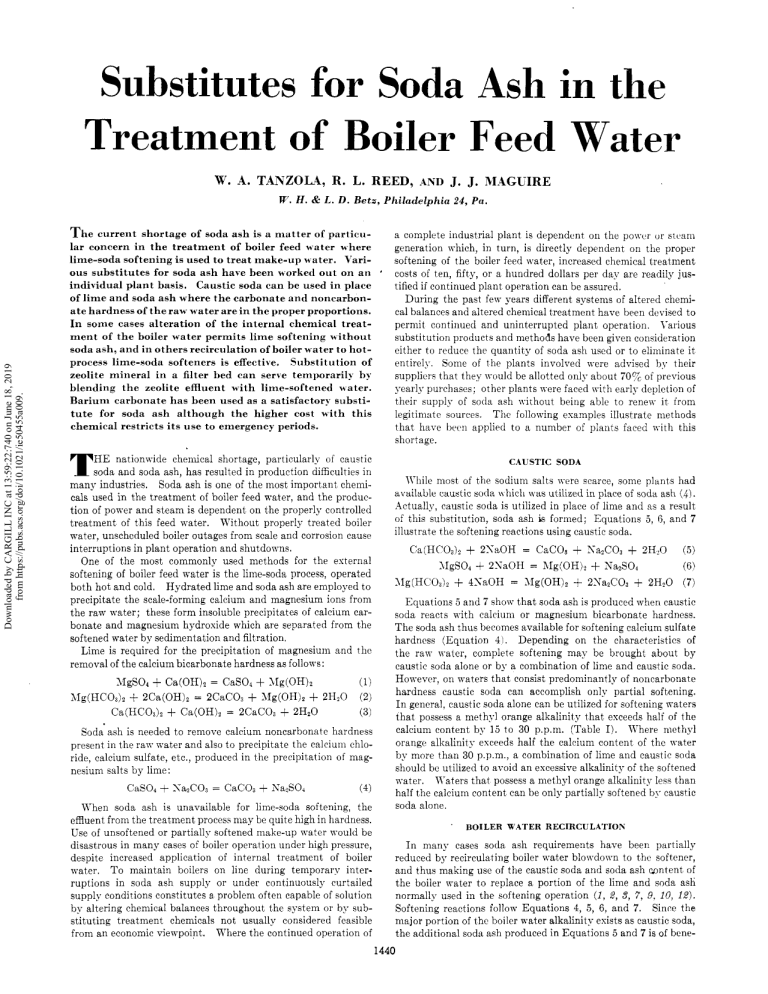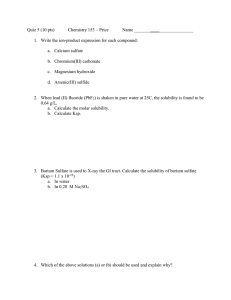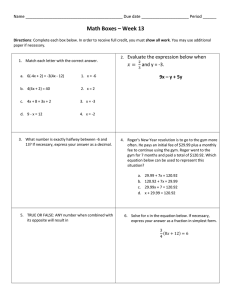
Substitutes for Soda Ash in the
Treatment of Boiler Feed Water
W. A. TANZOL4, R. L. REED, AND J. J. MAGUIRE
W. H. & L. D. Betz,
Philadelphia
Downloaded by CARGILL INC at 13:59:22:740 on June 18, 2019
from https://pubs.acs.org/doi/10.1021/ie50455a009.
The
current
shortage of soda ash is a matter of particuin the treatment
lar concern
of boiler feed water where
lime-soda softening is used to treat make-up water.
Various
substitutes for soda ash have been worked out on an
individual plant basis. Caustic soda can be used in place
of lime and soda ash where the carbonate and noncarbonate hardness of the raw water are in the proper proportions.
In some cases alteration of the internal chemical treatof the boiler water permits lime softening without
ment
soda ash, and in others recirculation of boiler water to hotprocess lime-soda softeners is effective. Substitution of
zeolite mineral in a filter bed can serve temporarily bv
blending the zeolite effluent with lime-softened water.
Barium carbonate has been used as a satisfactory substitute
for soda ash although the higher cost with this
chemical restricts its use to emergency periods.
complete industrial plant is dependent on the power or steam
generation which, in turn, is directly dependent on the proper
softening of the boiler feed water, increased chemical treatment
costs of ten, fifty, or a hundred dollars per day are readily justified if continued plant operation can be assured.
During the past few years different systems of altered chemical balances and altered chemical treatment have been devised to
permit continued and uninterrupted plant operation. Various
substitution products and methods have been given consideration
either to reduce the quantity of soda ash used or to eliminate it
entirely. Some of the plants involved were advised by their
suppliers that they would be allotted only about 70% of previous
yearly purchases; other plants were faced with early depletion of
their supply of soda ash without being able to renew it from
The following examples illustrate methods
legitimate sources.
that have been applied to a number of plants faced with this
shortage.
a
'
nationwide chemical shortage, particularly of caustic
soda and soda ash, has resulted in production difficulties in
THE
many industries. Soda ash is one of the most important chemicals used in the treatment of boiler feed water, and the production of power and steam is dependent on the properly controlled
treatment of this feed water. Without properly treated boiler
water, unscheduled boiler outages from scale and corrosion cause
interruptions in plant operation and shutdowns.
One of the most commonly used methods for the external
softening of boiler feed water is the lime-soda process, operated
both hot and cold. Hydrated lime and soda ash are employed to
precipitate the scale-forming calcium and magnesium ions from
the raw water; these form insoluble precipitates of calcium carbonate and magnesium hydroxide which are separated from the
softened water by sedimentation and filtration.
Lime is required for the precipitation of magnesium and the
removal of the calcium bicarbonate hardness as follows:
+ Ca(OH)2
+ Mg(OH)2
2CaC03 + Mg(OH)2 + 2H,0
Mg(HC03)2 + 2Ca(OH)2
2CaC03 + 2H20
Ca(HC03)2 + Ca(OH)2
MgSCh
=
CaS04
=
=
CAUSTIC SODA
While most of the sodium salts were scarce, some plants had
available caustic soda which was utilized in place of soda ash (4).
Actually, caustic soda is utilized in place of lime and as a result
of this substitution, soda ash is formed; Equations 5, 6, and 7
illustrate the softening reactions using caustic soda.
Ca(HC03)2 + 2XaOH
CaC03 + Xa2C03 + 2H.0
2XaOH
Mg(OH), + Xa2S04
MgS04 +
Mg(HC03)2 + 4XaOH
Mg(OH)2 + 2Xa2C03 + 2H20
=
=
CaC03 + Xa2S04
(5)
(6)
(7)
Equations 5 and 7 show that soda ash is produced when caustic
soda reacts with calcium or magnesium bicarbonate hardness.
The soda ash thus becomes available for softening calcium sulfate
hardness (Equation 4). Depending on the characteristics of
the raw water, complete softening may be brought about by
caustic soda alone or by a combination of lime and caustic soda.
on waters that consist predominantly of noncarbonate
hardness caustic soda can accomplish only partial softening.
In general, caustic soda alone can be utilized for softening waters
that possess a methyl orange alkalinity that exceeds half of the
calcium content by 15 to 30 p.p.m. (Table I). Where methyl
orange alkalinity exceeds half the calcium content of the water
by more than 30 p.p.m., a combination of lime and caustic soda
should be utilized to avoid an excessive alkalinity of the softened
Waters that possess a methyl orange alkalinity less than
water.
half the calcium content can be only partially softened by caustic
soda alone.
However,
(1)
(2)
(3)
remove
CaS04 + Xa2C03
=
=
calcium noncarbonate hardness
present in the raw water and also to precipitate the calcium chloride, calcium sulfate, etc., produced in the precipitation of magnesium salts by lime:
Soda ash is needed to
24, Pa.
(4)
When soda ash is unavailable for lime-soda softening, the
effluent from the treatment process may be quite high in hardness.
Use of unsoftened or partially softened make-up water would be
disastrous in many cases of boiler operation under high pressure,
despite increased application of internal treatment of boiler
To maintain boilers on line during temporary interwater.
ruptions in soda ash supply or under continuously curtailed
supply conditions constitutes a problem often capable of solution
by altering chemical balances throughout the system or by substituting treatment chemicals not usually considered feasible
from an economic viewpoint. Where the continued operation of
BOILER WATER
RECIRCULATION
In many cases soda ash requirements have been partially
reduced by recirculating boiler water blowdown to the softener,
and thus making use of the caustic soda and soda ash content of
the boiler water to replace a portion of the lime and soda ash
normally used in the softening operation {1, 2, S, 7, 9, 10, 12).
Softening reactions follow Equations 4, 5, 6, and 7. Since the
major portion of the boiler water alkalinity exists as caustic soda,
the additional soda ash produced in Equations 5 and 7 is of bcne1440
INDUSTRIAL
November 1947
Table I.
Applicability
Raw Water Characteristics'
.
VjCa + (15-30 p.p.m.
3
XI unethyl orange
Table II.
Hardness
CaCOj,
as
as
180
120
60
20
0
32
60
3d
10
Complete
0
16
4
Boiler
Water
With Recirculation^
Lime-soda
Raw softened Boiler
180
120
60
20
0
120
35
10
32
60
0
16
4
CaCOj,
p.p.m.
Phenolphthalein
Methyl
Softening
Partial
Complete
CaCOj.
Without Recirculation3
Lime-soda
Raw softened Boiler
p.p.m.
Sulfate
as
Analyses with and without
Recirculation
Ca as CaCOj, p.p.m.
XIg as CaCOj, p.p.m.
Alkalinity
alkalinity) and Ca
orange
as SO4
Chloride
120
3o
10
630
700
o38
154
60
CHEMISTRY
336
374
538
154
60
as Cl
19
Phosphate as PO*
7.3
10.1
11.7
7.3
10.1
11.5
pH
a
Lime requirement, 147 p.p.m. on raw water; soda ash, 106 p.p.m. on
raw water.
6.5 %> boiler water blowdown (69,500 pounds per million pounds
BARIUM CARBONATE
Barium carbonate was considered an emergency substitute
for soda ash. Lime-barium softening for reducing the sulfate
concentration is a process of historical interest but is in use, to the
authors’ knowledge, at only one plant in this country (-5, 6, 8, It).
Barium carbonate was applied during the soda ash shortage, not
with the primary intention of reducing the sulfate content of the
treated water, but rather to obtain the advantage of the sod urn
carbonate produced as a by-product of sulfate removal:
+ BaCO,
CaSO, + BaCOs
MgSO, + BaCO,
MgCOs + Ca(OH)2
Xa2S04
•steam).
Lime requirement, 132 p.p.m, on raw water; soda ash, $4 p.p.m. on
water.
raw
6.5% system blowdown (139,000 pounds per million pounds
steam, of which 69,500 pounds are returned to softener).
b
tit in the removal of noncarbonate hardness as illustrated by
Equation 4.
Table II shows the normal balances maintained on a hot process
softener and the resulting boiler water characteristics, as well as
the balances utilizing boiler water recirculation to the softener to
bring about a reduction in soda ash requirements. As a result of
recirculation, the reduction in lime requirements was approximately 10% and in soda ash requirements, 21%. A normal balance was maintained on the softener, and all factors of the boiler
water balance remained the same with the exception of boiler
water alkalinity. The reduction of boiler water alkalinity is a
direct result of consuming it in the softening process. In many
cases reduction in boiler water alkalinity is a desirable feature to
minimize carry-over that may result from excessive boiler water
alkalinity; boiler water is often recirculated solely for this purpose.
In general, the application of boiler water recirculation to waters
that, consist predominantly of carbonate hardness brings about
a greater percentage saving in soda ash than is covered by the
case cited.
Noncarbonate hardness waters involve only a minor
percentage savings in the soda ash requirements.
ZEOLITE
=
=
CaZ + 2XaHCO
MgZ + Xa2S04
=
=
BaSO, + Na.CO,
BaSO, + CaCO,
BaSO, + CaSO,
(10)
CaCO, + Mg(OH)2
(13)
(11)
(12)
Blending of Zeolite Softened Water Prior
Lime-Soda Softening (in Parts per Million)
Table III.
to
ZeoliteSoftened
Raw?
Hardness as CaCOj
Ca as CaCOj
Xlg
as
CaCOj
Alkalinity
CaCOj
Phenolphthalein
Blended b
Lime-Soda
Softened
121
20
84
37
16
4
0
160
110
50
4
0
130
30
0
130
30
130
30
32
60
30
12
12
12
12
as
Xlethyl orange
Sulfate as SO<
Chloride as Cl
Chemical requirements: lime, 149 p.p.m.; soda ash, 68 p.p.m.
b
75% raw water, 25% zeolite-softened. Chemical requirements:
137 p.p.m.;
soda ash, 27 p.p.m.;
salt, 140 p.p.m.
a
Table IV.
Blending
of
Lime-Soda Effluent
Raw
plants faced with the need for reducing soda ash
requirements had enough filters and filtering capacity to permit
conversion of one of the filters to a zeolite softening unit, operated
In the zeolite softening process calcium
on the sodium cycle.
and magnesium hardness is removed in exchange reactions with
sodium ions substituted for the calcium and magnesium:
=
=
As reaction 10 shows, sodium carbonate is formed by the reaction between barium carbonate and sodium sulfate present in
the raw water. The sodium carbonate is then available for use
in accordance with reaction 4. In addition, as reactions 11, 12,
and 13 show, calcium sulfate and magnesium sulfate can be removed without the use of soda ash.
SOFTENING
A few of the
Ca(HCO,)$ + Na»Z
MgSOi + Xa2Z
1441
In some of the plants employing batch cold-process lime-soda
softeners with gravity filters, consideration was given to converting one of the gravity filters to a gravity zeolite softener and
blending the effluents of both softening processes to produce a
water as illustrated in Table IV. The quantity of soda ash saved
by this procedure ivas in proportion to the amount of water softened by the zeolite unit. Since only 75% of the make-up water
was softened by the lime-soda process, a direct saving of 25% in
soda ash was achieved.
Degree of
Caustic soda
Caustic soda
Caustic soda
and lime
M > VsCa 4- 30 p.p.m.
ENGINEERING
Caustic Soda
of
Treatment
< i/2Ca
=
AND
Hardness as CaCO,
Ca as CaCOj
Xlg as CaCOj
Alkalinity as CaCOj
Phenolphthalein
Xlethyl
orange
Zeolite Softened Water
(in Parts per Million)
Lime-Soda
Softened
220
160
60
35
25
0
45
80
100
Zeolite
Softened
lime,
with
Blended'1
4
28
0
100
35
85
80
30
10
80
80
80
Sulfate as SO4
30
30
30
Chloride as Cl
3
75% cold lime-soda softened, 25% zeolite-softened.
8;
(9;
Reaction 8 shows that the bicarbonate hardness is converted to
sodium bicarbonate. When the zeolite softened water is blended
with the raw water, the resulting characteristics are such that
the hardness becomes totally carbonate. Table III shows the
make-up of the blended water and the resulting softened water,
which brought about a saving of 8% in lime and 60% in soda
ash. At the same time the external chemical treatment cost
was slightly lower with this treatment than was obtained by the
normal procedure. By softening increased percentages of the
raw water by the zeolite process, the use of soda ash could be
totally eliminated.
where the natural sodium sulfate content of the
insufficient to produce the desired sodium carbonate excess required in the softener effluent, it· was necessary
to feed sodium sulfate to the softener and thereby produce soda
ash directly in accordance with reaction 10.
Theoretical efficiency in the use of barium carbonate to produce soda ash has not been obtained in either laboratory test or
full scale plant operation. Barium carbonate can be used in both
hot· and cold softening, but its action is more efficient in the hot
(Table V).
Table V illustrates hot process tests in which normal softening
action is obtained with theoretical quantities of lime and soda
In
raw
some
cases
water
was
INDUSTRIAL
1442
Table V.
Results
of
Raw
AND
ENGINEERING
Laboratory Tests on Hot
with
Barium Carbonate
and
ments
100
Barium carbonate
Sodium sulfate
Amounts used, p.p.m,
172
Soda ash
Barium carbonate
Sodium sulfate
Analysis, p.p.m.
Hardness as CaCOt
Ca as CaCOt
Mg as CaCOt, p.p.m.
Alkalinity as CaCOt
Phenolphthalein
Methylorange
Sulfate as SO4
Chloride as Cl
0
Conditions of test:
Conditions of test:
100
100
172
200
100
100
100
100
100
100
150
150
150
...
100
100
100
172
172
200
24
21
172
172
172
370
223
370
334
555
334
38
23
15
248
168
80
170
172
4
3
26
34
30
164
46
64
30
...
248
168
176
174
16
14
68
80
2
2
13
52
30
22
0
6
16
16
6
12
12
0
38
128
164
44
96
164
100
30
164
100
30
30
40
30
24
80
164
164
164
164
164
1-hour retention, 20( 0 F. 1.0-liter samples.
4-hour retention, 80° F., 1.0-liter samples.
Lime alone is effective in precipitation of magnesium, but
obviously additional softening power is required to reduce the
calcium content. Using theoretical quantities of barium carbonate and sodium sulfate as substitutes for soda ash yields
reasonably satisfactory results, with reduction in calcium to 55
p.p.m. as calcium carbonate. Further improvement in lowering
the hardness of the treated water is obtained with additional
barium carbonate and sodium sulfate.
Table V also shows the results of cold process tests with the
same raw water.
Application of theoretical quantities of barium
carbonate and sodium sulfate does not achieve the same degree
of hardness removal as secured at higher temperatures. Increased quantities of barium carbonate and sodium sulfate show
steadily decreased calcium contents of the softened water, but
these data indicate that this process 15 considerably less efficient
at lower temperatures, possibly as a result of lower barium carbonate solubility at lower temperatures.
The insoluble barium sulfate precipitate formed in these reactions is removed along with the calcium carbonate and magnesium hydroxide through sedimentation and filtration as in
normal lime-soda softener operation. Inasmuch as barium salts
are toxic, qualitative barium determinations were conducted on
the softener effluent, and the efficiency of filtration was also
checked closely to make oertain> of the removal of the finely
divided barium sulfate precipitate. Only small traces of barium
ash.
were
The
Cold Processes
11
for this condition
reason
has not been closely investigated but was possibly due to
insoluble barium sulfate
coating on the barium carbonate particles. In addition,
100 100 100 100 100
100
slightly larger lime charges
Í0Ó 10Ó 150 2ÓÓ 250
300
were
required, of the order
100 150 150 200 250
300
of approximately 10%. In
172 172 172 172 172
172
general, reasonably good agree370 370
740 925 1110
ment is observed between labo223 334 334 466
670
ratory and field tests on the
112 118
66
96
60
56
hot process use of barium car105 101
42
33
31
17
19
24
25
27
bonate.
26
26
26
36
48
54
The use of barium carbonate
38
40
52
36
74
92
in place of soda ash does not
112 176 152 192 248
296
164 164 164 164 164
164
require alteration of normal
softener control procedures, so
no disadvantage has been encountered in this phase of operation. Lime control can be
established on the basis of maintaining certain residual hydrate
alkalinity values, and barium carbonate.can be regulated to develop optimum excess carbonate alkalinity concentrations. Determinations for excess sodium sulfate would not be imperative
since experience proved that the feed of this material, if required,
could be adjusted in direct ratio to the barium carbonate charges.
Some state health authorities consider the barium-containing
sludge to be a health hazard and will not permit it to be dumped
in waterways. Potential users of barium carbonate process who
must discharge sludge to streams and rivers should seek information concerning the attitude of their state health authorities
before installing the process.
Treated waters
% of theoretical requireSoda ash
Vol. 39, No.
an
Raw
Treated waters
CHEMISTRY
Table VI.
Results of Field Tests with
(in Parts per Million)
Raw
Hardness as CaCOt
Ca as CaCOt
Mg as CaCOt
Alkalinity as CaCOt
Phenolphthalein
Methyl
orange
Sulfate as SO*
Chloride as Cl
a
Theoretical
b Theoretical
c
10% excess
d 10% excess
Water
No. Ia
188
122
66
50
40
10
0
26
40
24
8
48
152
8
lime and barium
lime; 50% excess
lime; 25% excess
lime; 40% excess
-Soft*
No. 2»
38
28
the
Hot Process
Efflu
No. 3C No. 4d
mer
No. 5d
22
16
14
2
14
12
2
34
32
26
40
28
30
50
24
30
52
36
8
8
8
8
10
16
carbonate; no sodium sulfate,
barium carbonate; no sodium sulfate.
barium carbonate and sodium sulfate.
barium carbonate and sodium sulfate.
observed.
During initial application of barium carbonate to plant operation, the raw make-up water to the softener was depended upon to
supply the amount of sulfate required for barium precipitation.
Sulfate removal taking place during this process decreases the
dissolved solids of the softener effluent, which is beneficial in
numerous
applications. Further analyses revealed that 100%
of the natural sulfate content of the raw water did not react with
the barium carbonate, but rather a sulfate residual of 20-40
p.p.m. as SO, remained in the softener effluent. Consequently,
not enough carbonate w-as produced to yield as complete noncarbonate hardness removal as desired. Barium carbonate fed
considerably in excess of theoretical requirements failed to produce further sulfate or hardness reduction. Excess barium carbonate feed without the sulfate available for precipitation was
simply wasted, since this material remained in an insoluble, inert
form.
Table VI illustrates the results obtained in field tests with
barium carbonate in conjunction with a hot process lime-soda
softener, having a capacity of 10,000 gallons per hour and operating at 218° F. Somewhat greater than theoretical quantities
of barium carbonate were required, varying from 25-40%.
Assuming reaction 10 to proceed at 100% theoretical efficiency,
the cost of the soda ash thus produced is 6.2 cents per pound.
This cost is based on 3.25 cents per pound for barium carbonate
of 98% purity and sufficient natural sulfate content of the raw
water to complete the reaction. Where sodium sulfate must be
supplied for the reaction, based on a cost of 2.1 cents per pound
for this chemical, the cost of thus producing soda ash is 9.0 cents
per pound. Where higher than theoretical quantities of barium
carbonate and sodium sulfate are necessary, the cost of producing
soda ash is correspondingly increased.
All applications proved that barium carbonate gave as great a
hardness reduction as possible with the conventional use of
soda ash. Obviously, operating chemical costs increased as a
result of the cost of barium carbonate in comparison with soda
ash and also the necessity of employing sodium sulfate in a large
number of cases. However, the use of barium carbonate enables
normal softening operations to be maintained during emergency
periods when the soda ash supply may be inadequate, and thereby
permits continuous operation without fear of interrupted pro-
duction.
INDUSTRIAL
November 1947
AND ENGINEERING
ACKNOWLEDGMENT
The authors wish to thank J. W. Polsky, who conducted the
majority of the laboratory tests, and also express appreciation
to W. H. & L. D. Betz for permission to present these data.
LITERATURE
CITED
(1) Baker, Combustion, 12, 31-4 (1940).
(2) Betz, Handbook of Industrial Water
547 (1945).
(3) Flickinger, Power, 85, 115-20 (1941).
Conditioning, Chap. IS, p.
(4)
(5)
(6)
(7)
(8)
(9)
(10)
(11)
(12)
CHEMISTRY
1443
Heiskell, Ibid., 90, 747-9 (1946).
Hundesshagen, Z. offentl. Chem., 24, 159-67, 175-86 (1918).
Leick, Vom Wasser, 7, 197-205 (1933).
Maguire and Tomlinson, Combustion, 11, 26-32 (1939).
Mehring, Chem. & Met. Eng., 21, 629-32 (1919).
Paris. Chaleur & industrie, 5, 277-9 (1924).
Paris, Chimie & industrie, 4, 722-30 (1920).
Rodman, Chem. & Met. Eng., 35, 221-3 (1928).
Sperry, Combustion, 10, 27-33 (1939).
Received September 6, 1947. Presented before the Division of Water,
Sewage, and Sanitation Chemistry at the 112th Meeting of the American
Chemical Society, New York, X, Y.
Butanol-Acetone Fermentation
of Wood Sugar
REID H. LEONARD AND W. H. PETERSON
GEORGE J. RITTER
University of Wisconsin, Madison, Wis.
United States Forest Products Laboratory, Madison, Wis.
Wood hydrolyzates were fermented with Clostridium
The wood
butylicum No. 39 to butanol and acetone.
species and method of hydrolysis affect the fermentability
of the liquors. Very mild or very vigorous conditions of
by the Madison wood sugar process as described by Harris and
Beglinger (4). These samples were neutralized to pH 4.2 with
lime at 138° C. (4, 7). The oak sample represented the first
25% of the hydrolyzate received from the digester, and the
Douglas fir liquor was from a normal run.
hydrolysis do not produce an easily fermentable solution.
Complete utilization of sugar could be obtained up to 3%
concentrations.
Solvent yields ranged from 24 to 38% of
the sugar fermented.
fermentation of wood hydrolyzates by butanol-acetone
is difficult. Sjolander, Langlykke, and Peterson
(10) conducted butanol-acetone fermentations on hydrolyzates
prepared by a method similar to the Scholler process and obtained a fermentable medium after precipitation of metals at
pH 10, neutralization, and clarification with Norite decolorizing
carbon. In the present paper other types of hydrolyzates have
been studied, and attempts have been made to simplify the pretreatments for fermentation.
Two cultures had previously been selected for wood sugar fermentations: Cl. felsineum Carbone No. 41 by Sjolander et al.
(10) for hydrolyzates and Cl. butylicum (Fitz strain) No. 39
by Wiley et al. (11) for sulfite waste liquor fermentation. These
two cultures, as well as Cl. butylicum No. 37, Cl. beijerinckii
No. 67, and Cl. butylicum No. 69, were compared on wood hydrolyzate, and No. 39 was selected as the most suitable organism.
Fermentations were conducted with cultures transferred three
to five times from the spore stock. Nutrients were supplied
by 1% malt sprouts and 0.1% (NHtRHPO». A trace of reduced
iron was added to the media before autoclaving. From 0.1 to
0.3% calcium carbonate was added to the media after inoculation. Inoculum was produced on glucose-malt sprouts medium
and used after 12 to 20 hours at 8% of the fermentation volume.
Determination of reducing sugars was made by the method of
Shaffer and Somogyi (9); furfural by a colorimetric method (1);
ethanol and butanol by Johnson’s procedure (6); and acetone by
Goodwin’s method (3). Volatile acids were determined by
titration of 11 volumes of distillate from 1 volume of sample.
Hydrolyzates of maple and spruce were prepared in a rotary
digester similar to that described by Plow et al. (8). Maple
sawdust was hydrolyzed by 3% sulfuric acid with an acid-wood
ratio of 1:1 at 181° C. for 30 minutes. A milder hydrolysis of
maple and of spruce was made with 1.8% acid, ratio 1:1 at
173° C. for 5 minutes. Oak and Douglas fir were hydrolyzed
THE
bacteria
FACTORS AFFECTING
FERMENTATION
It was first desirable to repeat the results of Sjolander et al.
In their work the amount of decolorizing carbon was not stated,
and it was found that with maple hydrolyzate, following their
procedure, 10 to 20 grams of Norite decolorizing carbon per 100
ml. were required to duplicate their fermentation results. Fermentation of high temperature maple hydrolyzate prepared
in this manner showed that 92% of the sugar in a 4.04 grams per
100 ml. solution was fermented in 5 days. The quantity of decolorizing carbon was found to be important; the use of 1 gram
per 100 ml. resulted in the fermentation of 25% of the sugar,
5
grams gave 64%, 10 grams gave 72%, and 20 grams gave 93%.
After the furfural was removed from the sample, the quantity of
carbon required was decreased to less than 5 grams per 100 ml.
The pH was found to be important, since 1 gram of carbon at pH
2.0 gave 17% fermentation, while 1 gram at pH 6.8 gave 51%.
The difficulty found with maple wood hydrolyzates was also
found with spruce, Douglas fir, and oak. The fermentations
were characterized by a long induction period and a slow sugar
utilization. In some samples much of the inhibition could be
accounted for by the presence of furfural—for example, the
°
maple hydrolyzate made at 181 C. contained from 0.5 to 0.8
gram of furfural per 100 ml. On synthetic medium 0.1% furfural decreased the fermentation by 15%. Hydrolyzates containing more than 0.1% furfural stopped the development of
the bacteria completely. Furfural was removed easily by distillation or by passing the liquor through a steam stripping colWhen furfural was added back to the stripped liquor,
umn.
the fermentations were not inhibited to the same extent as initially. This indicated that substances other than furfural were
removed by the distillations.
When the concentration of the inhibitory substances was decreased by dilution of the liquor, the extent of fermentation was
improved. Complete fermentation of sugars in wood hydrolyzates was usually obtained at about 3% concentration. With
glucose-malt sprouts medium 5% concentration was about the
maximum quantity which could be completely fermented with




